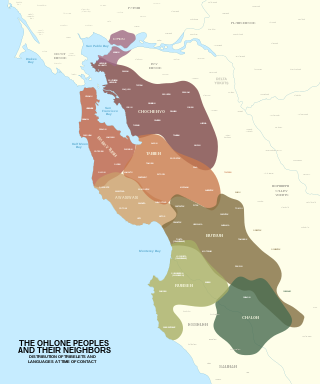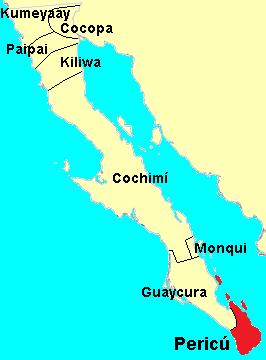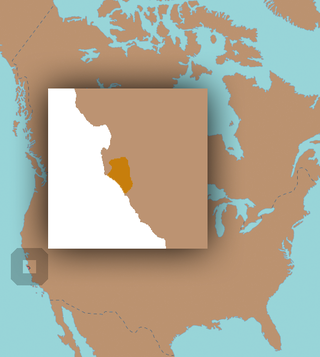
Mission San Carlos Borromeo del Río Carmelo, or Misión de San Carlos Borromeo de Carmelo, first built in 1797, is one of the most authentically restored Catholic mission churches in California. Located at the mouth of Carmel Valley, California, it is on the National Register of Historic Places and is a National Historic Landmark.

The Ohlone, formerly known as Costanoans, are a Native American people of the Northern California coast. When Spanish explorers and missionaries arrived in the late 18th century, the Ohlone inhabited the area along the coast from San Francisco Bay through Monterey Bay to the lower Salinas Valley. At that time they spoke a variety of related languages. The Ohlone languages make up a sub-family of the Utian language family. Older proposals place Utian within the Penutian language phylum, while newer proposals group it as Yok-Utian.

The Rumsen language is one of eight Ohlone languages, historically spoken by the Rumsen people of Northern California. The Rumsen language was spoken from the Pajaro River to Point Sur, and on the lower courses of the Pajaro, as well as on the Salinas and Carmel Rivers, and the region of the present-day cities of Salinas, Monterey and Carmel.

The Hokan language family is a hypothetical grouping of a dozen small language families spoken mainly in California, Arizona, and Baja California.

The Esselen are a Native American people belonging to a linguistic group in the hypothetical Hokan language family, who are indigenous to the Santa Lucia Mountains of a region south of the Big Sur River in California. Prior to Spanish colonization, they lived seasonally on the coast and inland, surviving off the plentiful seafood during the summer and acorns and wildlife during the rest of the year.

Penutian is a proposed grouping of language families that includes many Native American languages of western North America, predominantly spoken at one time in British Columbia, Washington, Oregon, and California. The existence of a Penutian stock or phylum has been the subject of debate among specialists. Even the unity of some of its component families has been disputed. Some of the problems in the comparative study of languages within the phylum are the result of their early extinction and limited documentation.

Washo is an endangered Native American language isolate spoken by the Washo on the California–Nevada border in the drainages of the Truckee and Carson Rivers, especially around Lake Tahoe. While there are only 20 elderly native speakers of Washo, since 1994 there has been a small immersion school that has produced a number of moderately fluent younger speakers. The immersion school has since closed its doors and the language program now operates through the Cultural Resource Department for the Washoe Tribe. The language is still very much endangered; however, there has been a renaissance in the language revitalization movement as many of the students who attended the original immersion school have become teachers.

The Salinan are a Native American tribe whose ancestral territory is in the southern Salinas Valley and the Santa Lucia Range in the Central Coast of California. Today, the Salinan governments are now working toward federal tribal recognition from the Bureau of Indian Affairs.

Yokuts, formerly known as Mariposa, is an endangered language family spoken in the interior of Northern and Central California in and around the San Joaquin Valley by the Yokuts people. The speakers of Yokuts languages were severely affected by disease, missionaries, and the Gold Rush. While descendants of Yokuts speakers currently number in the thousands, all languages apart from Valley Yokuts are now extinct.

Chumashan was a family of languages that were spoken on the southern California coast by Native American Chumash people, from the Coastal plains and valleys of San Luis Obispo to Malibu, neighboring inland and Transverse Ranges valleys and canyons east to bordering the San Joaquin Valley, to three adjacent Channel Islands: San Miguel, Santa Rosa, and Santa Cruz.

The Shastan family consisted of four languages, spoken in present-day northern California and southern Oregon:

The Yuki–Wappo or Yukian languages are a small language family of western California consisting of two distantly related languages, both now extinct.

The Chalon people are one of eight divisions of the Ohlone (Costanoan) people of Native Americans who lived in Northern California. Chalon is also the name of their spoken language, listed as one of the Ohlone languages of the Utian family. Recent work suggests that Chalon may be transitional between the northern and southern groups of Ohlone languages.

The Plains and Sierra Miwok were once the largest group of California Indian Miwok people, Indigenous to California. Their homeland included regions of the Sacramento Valley, San Joaquin Valley, and the Sierra Nevada.
The Ventana Wilderness of Los Padres National Forest is a federally designated wilderness area located in the Santa Lucia Range along the Central Coast of California. This wilderness was established in 1969 when the Ventana Wilderness Act redesignated the 55,800-acre (22,600 ha) Ventana Primitive Area as the Ventana Wilderness and added land, totalling 98,000 acres. In 1978, the Endangered American Wilderness Act added 61,000 acres, increasing the total wilderness area to about 159,000 acres. The California Wilderness Act of 1984 added about 2,750 acres. The Los Padres Condor Range and River Protection Act of 1992 created the approximately 14,500-acre (5,900 ha) Silver Peak Wilderness and added about 38,800 acres to the Ventana Wilderness in addition to designating the Big Sur River as a Wild and Scenic River. The Big Sur Wilderness and Conservation Act of 2002 expanded the wilderness for the fifth time, adding nearly 35,000 acres (14,000 ha), increasing the total acreage of the wilderness to its present size of 240,026 acres (97,135 ha).

Slates Hot Springs is the site of a hot spring in the Big Sur region of Monterey County, California. It is located 8 miles (13 km) north-northwest of Lopez Point, at an elevation of 118 feet.

The Ohlone languages, also known as Costanoan, form a small Indigenous language family historically spoken in Northern California, both in the southern San Francisco Bay Area and northern Monterey Bay area, by the Ohlone people. Along with the Miwok languages, they are members of the Utian language family. The most recent work suggests that Ohlone, Miwok, and Yokuts are branches of a Yok-Utian language family.

Waikuri is an extinct language of southern Baja California spoken by the Waikuri or Guaycura people. The Jesuit priest Baegert documented words, sentences and texts in the language between 1751 and 1768.

The Rumsen are one of eight groups of the Ohlone, an indigenous people of California. Their historical territory included coastal and inland areas within what is now Monterey County, California, including the Monterey Peninsula.

Pericú is the extinct and essentially unattested language of the Pericú people who lived at the southern tip of Baja California Sur. Jesuit missionaries recognized it as distinct from Waikuri (Guaycura) immediately to the north. It was spoken in the mountainous area around the mission of San José del Cabo, on the southeastern coast from Santiago to La Paz, and on the islands off the east coast as far north as Isla San José.



















